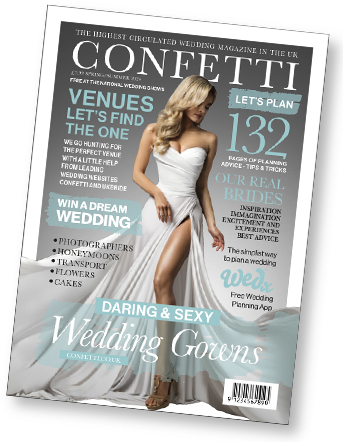Your guide to the traditional wedding reception order of events
Traditionally, there is a set timetable of events at wedding receptions. Of course, you don’t have to do any of these things if you don’t want to, but knowing about them can help you give shape to your party.
The wedding reception line‐up
A formal receiving line is where the bride and groom line up with both sets of parents and greet each guest as they come into the reception. However, it can be just the couple that receive their guests. If both sets of parents are in the line, it might be wise to go through the guest list together before the day so that everyone knows the guests’ names. If there are a lot of guests, this can cause quite a queue, so you might decide on an alternative way of saying ‘hello’ to everyone. One option is for the bride and groom to walk around and have a chat with guests on each table during the reception.
Speech!
Most wedding receptions include speeches and toasts. These should always be properly planned, rehearsed and timed. Usually they come at the end of the meal, although there is an increasing trend to have them before the meal begins. Usually, the father of the bride speaks and then toasts the bride and groom. Next comes the groom ‐‐ and the bride if she wants to make a speech. They thank their guests for coming and traditionally, the groom proposes a toast to the bridesmaids. The final speech is by the best man, who officially ‘replies’ on behalf of the bridesmaids.
Cake cutting
When the bride and groom cut the cake together, it’s symbolic of their shared future. After the cake cutting ceremony (usually at the very end of the meal and after the speeches), the caterers divide the cake into portions and it round to guests. There is an old English custom of placing a ring in the wedding cake. The guest that receives it will supposedly enjoy happiness for the next year. If you decide to serve your wedding cake for pudding, which is becoming increasingly popular, you will need to cut it before sitting down to eat, giving your caterers time to cut and serve it after the main course.
Get dancing
The evening is the time for everyone to relax and enjoy themselves and, maybe, go wild on the dance floor! Traditionally, the bride and groom start the dancing with a first dance. This would have been a waltz in the past, but now it’s whatever the couple choose.
During the first dance, it is also traditional for the groom to dance with his new mother‐in law and then with his mother, while the bride dances with her new father‐in law and then her father. The best man joins in by dancing with the chief bridesmaid and the ushers with the other bridesmaids.
Going away or staying to party
Guests are supposed to stay at the reception until the couple leaves, so if there is to be no formal ‘going away’ let your guests know (especially the older ones) that you intend to dance the night away!
Flower throwing
After the reception, the bride throws her bouquet over her shoulder towards a group of her unmarried friends and family. Traditionally, the one who catches the flowers (and survives the scrum!) will be the next to marry.
The equivalent for the groom is to remove the bride’s garter and throw it back over his shoulder for the unmarried men to fight over.
Customising the car
If the bride and groom are leaving the reception by car, chances are the best man et al will have attached various tin cans, balloons and other bits and pieces to the back of the vehicle. This stems from the old tradition of tying shoes to the back of the bride and groom’s carriage to represent the transfer of property from the father of the bride to the groom. Shouting and cheering, the shooting of fire crackers and the ringing of bells were supposed to protect the bride by warding off evil spirits!

